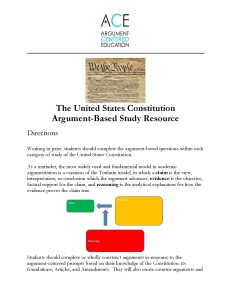
An Argument-Centered Approach to Teaching to the U.S. Constitution Exam
One of Argument-Centered Education’s high school partners’ 10th grade U.S. history classes are immersed right now in preparing students for their U.S. Constitution exam. “Time to take a break from our argument-centered projects,” a teacher opined. “Our Constitution exam curriculum is dry and content-heavy. We just to have to fill the kids with the facts about the articles, sections, and amendments, then they reproduce what they’ve learned. We’ll get back to debatification in February.”
Understood, was our first word. Our next two: But wait. We’d like the chance to work with your U.S. history teachers and classes to demonstrate a way of understanding an argument-based pedagogy that applies to contexts in which objectives are information-heavy and seek to instill in students the foundations of knowledge that will enable them later to engage in substantive academic or public debates.
For these purposes and in these academic environments — regardless of the discipline, we would submit — students can still organize their learning around arguments. Arguments provide weight to individual bits and bytes of data, and help students make information meaningful, enabling them to glean relationships between facts and to discern an ideational infrastructure that can bring the relevance of their study of details into clearer focus. Argument, in this sense, is what used to be called “information processing,” and is a variation on critical thinking applied to content delivery. Our work with this partner school’s history department has helped illustrate a theme that The Debatifier has been examining this school year, that argument-centered instruction should be understood as an especially effective vehicle for content delivery.
The centerpiece of our approach on using argument to prepare students for the U.S. Constitution exam has been this argument-based study guide:
The Constitution’s foundations, articles, and amendments are each taken up in the resource’s three sections. Students are required to adduce specific provisions, mandates, and framings throughout the nation’s founding political document — in the form of evidence for certain argumentative claims that can be and have been made about all of its aspects, not solely (or even especially) about its more controversial readings and interpretations. So, for example, the Study Guide requires specific details laid out in the numerous sections of the second article to substantiate this argumentative claim:
Article II of the Constitution emphasizes the President’s role as a representative of and decision-maker for the United States in its business and relations with other nations over his role in domestic public policy.
Students must demonstrate that they have assimilated the factual information that they will have to produce for the exam and then — surely as or more important to our students over the long-term — in all of their academic work forever thereafter that relates to our essential rules of governance by supplying reasoning that explicates the relevance and importance of the detailed information that they identify as evidence. In portions of the Study Guide they must grapple with counter-arguments, all the while staying close to an objective understanding of what the Constitution itself actually stipulates and says.
Learning this way is deeper, and more lasting, and better aligned with what students are required to do with the information they are supposed to have assimilated and retained, in college-level coursework when they are making academic arguments infused with and animated by their independent thought.
Website resources that we have found useful in conjuction with the Constitution Argument Study Guide include:
- The Interactive Constitution at the Constitution Center
- The Charters of Freedom: The U.S. Constitution
- The U.S. National Archives Docs Teach: The Constitution at Work
- Twyman and Whitney Constitution Test Prep
Incidentally, the Argument-Centered Education Constitution Study Guide can be downloaded by clicking on the link above. It is in writable pdf format, and prints without color in the response fields. Currently it is being used both as a by-topic teaching resource and as a later checking for higher understanding, prior to the exam. The results from these uses will of course await another report.


